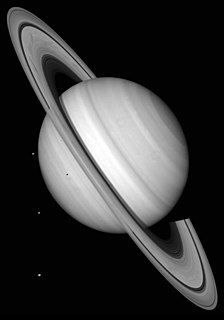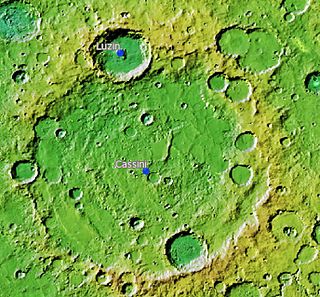 W
WGiovanni Domenico Cassini, also known as Jean-Dominique Cassini was an Italian mathematician, astronomer and engineer. Cassini was born in Perinaldo, near Imperia, at that time in the County of Nice, part of the Savoyard state. Cassini is known for his work in the fields of astronomy and engineering. Cassini discovered four satellites of the planet Saturn and noted the division of the rings of Saturn; the Cassini Division was named after him. Giovanni Domenico Cassini was also the first of his family to begin work on the project of creating a topographic map of France.
 W
WCésar-François Cassini de Thury, also called Cassini III or Cassini de Thury, was a French astronomer and cartographer.
 W
WThe rings of Saturn are the most extensive ring system of any planet in the Solar System. They consist of countless small particles, ranging in size from micrometers to meters, that orbit about Saturn. The ring particles are made almost entirely of water ice, with a trace component of rocky material. There is still no consensus as to their mechanism of formation. Although theoretical models indicated that the rings were likely to have formed early in the Solar System's history, new data from Cassini suggest they formed relatively late.
 W
WA Cassini oval is a quartic plane curve defined as the set of points in the plane such that the product of the distances to two fixed points is constant. This may be contrasted with an ellipse, for which the sum of the distances is constant, rather than the product. Cassini ovals are the special case of polynomial lemniscates when the polynomial used has degree 2.
 W
WThe Cassini–Huygens space-research mission, commonly called Cassini, involved a collaboration between NASA, the European Space Agency (ESA), and the Italian Space Agency (ASI) to send a space probe to study the planet Saturn and its system, including its rings and natural satellites. The Flagship-class robotic spacecraft comprised both NASA's Cassini space probe and ESA's Huygens lander, which landed on Saturn's largest moon, Titan. Cassini was the fourth space probe to visit Saturn and the first to enter its orbit. The two craft took their names from the astronomers Giovanni Cassini and Christiaan Huygens.
 W
WCassini is a crater on Mars named in honour of the Italian astronomer Giovanni Cassini. The name was approved in 1973, by the International Astronomical Union (IAU) Working Group for Planetary System Nomenclature.
 W
WCassini is a lunar impact crater that is located in the Palus Nebularum, at the eastern end of Mare Imbrium. The crater was named after astronomers Giovanni Cassini and Jacques Cassini. To the northeast is the Promontorium Agassiz, the southern tip of the Montes Alpes mountain range. South by south-east of Cassini is the crater Theaetetus. To the northwest is the lone peak Mons Piton.
 W
WCassini Regio is the enigmatic dark area that covers the leading half of Saturn's moon Iapetus. It is named after Giovanni Cassini, the discoverer of Iapetus; 'Regio' is a term used in planetary geology for a large area that is strongly differentiated in colour or albedo from its surroundings. The brighter half of Iapetus is composed of the Roncevaux Terra and the Saragossa Terra.